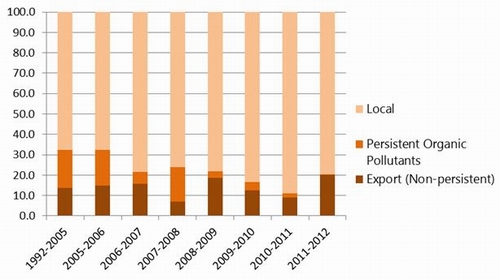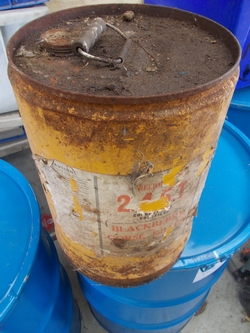Contaminated sites
What do we want to do with contaminated sites?
The operative Regional Policy Statement for Northland details existing council and community objectives for each natural and physical resource in our region. The objectives relating to hazardous waste are:
• Avoid remedy or mitigate the adverse effects on people and the wider environment arising from the storage, use, transportation and disposal of hazardous substances.
• Avoid, remedy or mitigate the adverse effects of the risks to people and the wider environment from existing contaminated sites.
The following are the anticipated environmental results after implementing the policies for hazardous waste management in the policy statement for Northland:
• Safer use, storage and disposal of pesticides and other agricultural chemicals and reduced risk of soil contamination. Increased public awareness of the risks associated with the improper use of hazardous substances.
• A reduction in the amount of hazardous waste requiring disposal.
• A reduction in the number of incidents of unauthorised disposal of hazardous waste.
• Greater control over the use of contaminated sites and protection against serious off-site environmental damage.
• Continued access to hazardous waste storage and disposal facilities.
• Safer use, storage and disposal of pesticides and other agricultural chemicals and reduced risk of soil contamination.
Note: the operative Regional Policy Statement is currently being reviewed. The proposed Regional Policy Statement (2013) is available at www.nrc.govt.nz/newRPS
What is a contaminated site?
A contaminated site is an area that has the potential to be contaminated with hazardous substances. Hazardous substances comprise those substances which present a significant danger to people and the environment because of their chemically reactive, explosive, flammable, corrosive, toxic or disease causing nature.
A variety of substances fall into this category, many of which are used in manufacturing industries. They range from oil-based products associated with the road construction and motor vehicle industries to various metallic products used in engineering, tanning and timber treatment operations. Pesticides and other agricultural chemicals are hazardous substances, although they can be used so as to not adversely affect people and the environment.
Where are the contaminated sites in Northland?
Locating contaminated sites
The regional council is tasked, under section 30(1)(ca) of the Resource Management Act 1991, with the investigation of land for the purposes of identifying and monitoring contaminated land.
The act defines contaminated land as land that has a hazardous substance in or on it that has, or is reasonably likely to have, significant adverse effects on the environment.
This section is about sites that appear on the Northland Regional Council's Selected Land Use Register (the register), as a result of investigation. Properties are placed on the register when there is a record of a past or present land use that could potentially result in contamination of the land.
Such contamination could impact on present and future users of that site, and this is done regardless of whether there is any confirmed contamination or not. Our role in managing this data also assists future landowners to establish whether a property has potential liabilities.
The Ministry for the Environment compiled the Hazardous Activities and Industries List (HAIL), which is a list of activities that have the potential to cause contamination and it is this list that drives the selected land use register.
Not all the sites that are listed in the register are actually contaminated. Some of the sites may be clear of contamination, but have never been scientifically tested to establish this.
The register lists sites according to various categories. These are shown in Table 13.
Table 13: Categories of hazardous sites in the Selected Land Use Register
| Category | Description | Explanation |
| U | Unverified history | History of land use on site is unverified. |
| V | Verified history | Land use history verified, but no sampling done. |
| 1 | Contamination confirmed | Sampling has confirmed contamination. No remediation has taken place. |
| 2 | Contamination acceptable, managed, remediated | Contamination that was identified has been removed or the site otherwise remediated. |
| 3 | No identified contamination | Sampling could not detect contamination. |
| 4 | Error | Sites that were placed on the register in error. |
Investigation generally involves research into the history of land use on a site. This includes researching historical aerial photographs and investigating reports about activities at sites that could cause land contamination. Council staff will occasionally visit a site and take samples, where the risk of contamination having a significant impact on the environment is high.
Sites that have been found to be significantly contaminated have to be managed by the owner, to ensure that discharges do not have adverse effects on the environment or people. The council has been involved with management of such sites including the issuing of consents for the discharge of contaminants and remediation.
The Selected Land Use Register details many sites throughout Northland that have a historical land use specified in the Ministry for the Environment's Hazardous Activities and Industries List. Although most of these sites are to be found in and around urban settlements and industrial areas, some of the sites are residential, while others are rural and in remote areas.
In January 2012, a nationally consistent set of planning controls came into effect to protect human health from contaminants in soils. The Resource Management (National Environmental Standard for Assessing and Managing Contaminants in Soil to Protect Human Health) Regulations 2011 (the NES) is implemented by territorial authorities which will ensure contaminants in soil are identified, assessed and remediated to make a site safe for human use.
The NES focusses on the potential impacts of soil contamination on human health. It does not take into account the environmental effects of soil contamination on the wider environment or the discharge of contaminants to land. These issues are managed by the regional council.
What are the issues associated with contaminated sites?
The main concern about contaminated land is that it could present a health risk to tenants, occupants or users of these sites, or result in significant contaminant discharges to the environment.
In the majority of cases, the investigation returns very low levels of contaminants. The liability for remediating a site generally falls on the current landowner. As such, ensuring that a site is not contaminated before you purchase it is very important.
Several sites are currently subject to resource consents which set out the conditions for the management of the sites. This includes monitoring of actual discharges and site management conditions.
What is being done?
The Northland Regional Council has, for the past 20 years, collected household hazardous waste and related material for repackaging and proper disposal. The council took the initiative at a time when there was no proper disposal service available in Northland to deal with waste that was too hazardous for landfilling in a responsible manner.
This service was originally started to rid the region of persistent chemicals, such as DDT, PCBs and 2,4,5-T that contained dioxin. The service has continued as it was realised that unwanted chemicals are still being found in cupboards, sheds and garages throughout the region.
The service has proven to be a very positive step towards protecting Northland's environment. At least 44 tons of waste chemicals and hazardous substances have been collected and sent for proper disposal over the past 20 years that it has been operational.
The graph (Figure 49) shows a decreasing trend in the amounts of persistent organic pollutants being received by the council. While the composition of hazardous waste has changed, the overall volume of total waste received each year is relatively the same.
Figure 49: Organic pollutants received by the Northland Regional Council through its hazardous waste collection service – types of waste expressed as a percentage of the total collected each year

The council still receives small quantities of hazardous substances, such as DDT, 2,4,5-T, pentachlorophenol, Dieldrin and a host of other chemicals that were banned or phased out many years ago. Most of these are in small containers, with bags or drums still appearing, but these have become the exception rather than the rule. This waste comes mainly from garages or sheds where ownership of the property has changed and the new owner has contacted the council to assist in disposing of leftover agrichemicals in the right way.
In recent years, the quantity of persistent organic pollutants received has decreased, while industrial waste substances left for the council to dispose of has increased. This led the council to review the service. Dealing with hazardous waste generated as a result of industrial processes is the responsibility of the person or business that created the waste and is a cost that must be built into any sustainable business. The intention now is to ensure that commercial generators of hazardous waste take more responsibility for their own waste management.
 A container of 2,4,5-T herbicide on top of drums of waste that has been sorted, packed, and ready for shipping.
A container of 2,4,5-T herbicide on top of drums of waste that has been sorted, packed, and ready for shipping.
How are we measuring up against our objectives?
Increased public awareness of the risks associated with the improper use of hazardous substances
• The public is increasingly aware of the dangers associated with the improper use of hazardous substances. This is shown in everyday enquiries about the disposal of waste hazardous substances and items such as energy saving light bulbs, smoke alarms, thermometers, and other household items that contain hazardous substances.
A reduction in the amount of hazardous waste requiring disposal
• While the amount of hazardous waste that must be sent abroad for destruction is decreasing, the actual amount of hazardous waste requiring disposal has stayed relatively constant. This is due to improved technology in New Zealand for treating some waste, and a change in the composition of waste which includes increased quantities of industrial waste that is being improperly disposed of.
A reduction in the number of incidents of unauthorised disposal of hazardous waste
• The number of reported incidents where hazardous substances have been dumped illegally is low. Only 14 incidents of hazardous substances dumping were reported over the period 2007-2011.
Greater control over the use of contaminated sites and protection against serious off-site environmental damage
• The Resource Management (National Environmental Standard for Assessing and Managing Contaminants in Soil to Protect Human Health) Regulations 2011 (NES) requires investigation of sites being subdivided or developed, to find out whether the site may be contaminated in a way that could affect human health. The NES will provide more certainty that land contamination is identified and managed. The NES compliments the work undertaken by the council as it will provide new information on the location and extent of soil contamination on sites being developed. Remediation of sites where contamination is identified will reduce the risk of further environmental damage.
Continued access to hazardous waste storage and disposal facilities
• The council's chemical collection service was renewed when the 2012-2022 Long Term Plan was prepared. The council now operates a reduced service that still provides for the collection and disposal of household hazardous chemicals deposited at district council refuse stations.
Safer use, storage and disposal of pesticides and other agricultural chemicals and reduced risk of soil contamination
• The council continues to drive efforts towards the safer use and storage of agricultural chemicals through various educational resources and through enforcement of the Regional Water and Soil Plan rules. The proper disposal of waste hazardous substances has been greatly facilitated by the hazardous chemical collection service over the past 20 years.
